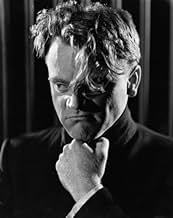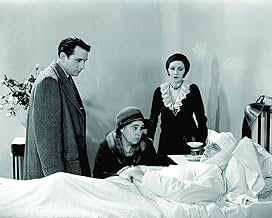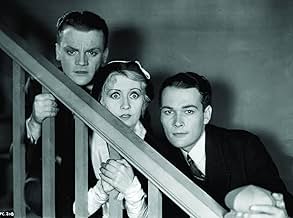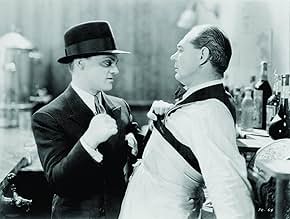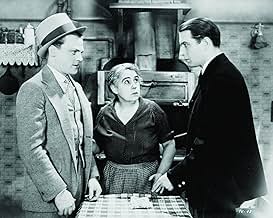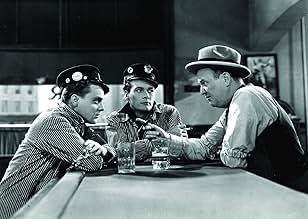Un joven matón va haciéndose un nombre en los bajos fondos de Chicago, incluso cuando la muerte accidental de un gángster amenaza con provocar una sangrienta guerra de bandas.Un joven matón va haciéndose un nombre en los bajos fondos de Chicago, incluso cuando la muerte accidental de un gángster amenaza con provocar una sangrienta guerra de bandas.Un joven matón va haciéndose un nombre en los bajos fondos de Chicago, incluso cuando la muerte accidental de un gángster amenaza con provocar una sangrienta guerra de bandas.
- Dirección
- Guionistas
- Elenco
- Nominado a 1 premio Óscar
- 1 premio ganado y 1 nominación en total
- Paddy Ryan
- (as Robert O'Connor)
- Goon
- (sin créditos)
- Dutch
- (sin créditos)
- Kitty
- (sin créditos)
- Tom as a Boy
- (sin créditos)
- Machine Gunner
- (sin créditos)
- Matt as a Boy
- (sin créditos)
- Miller
- (sin créditos)
- Molly Doyle
- (sin créditos)
- Nails' Girl
- (sin créditos)
- Dirección
- Guionistas
- Todo el elenco y el equipo
- Producción, taquilla y más en IMDbPro
Opiniones destacadas
Of course this film about a young man's rise to prominence in the bootleg liquor business during Prohibition made James Cagney a star. Interestingly enough Edward Woods was originally supposed to be Tom Powers and Cagney was cast as best friend Matt Doyle. After some footage had been shot, Director William Wellman scrapped it and had Cagney and Woods exchange roles. Stars get born in many and strange ways.
Some critics have complained about Beryl Mercer's part as Cagney's mother, saying she's overacts the ditziness. I disagree with that completely. In the prologue section with Cagney and Woods as juveniles, there is a two parent household. The boys have a stern Irish father and a mom who'd spoil them if she could. The older kid who is later played by Donald Cook has more the benefit of the two family home and both influences. That and the fact that World War I leaves him partially disabled prevents him from thinking about the gangster trade. Cagney misses the war and is spoiled by mom.
I knew a woman like Beryl, in her own world with a stream of nonsensical chatter to keep out the reality of things. Her portrayal for me rings true.
Oddly enough in The Roaring Twenties Cagney is a veteran who enters the rackets because he can't get a legitimate job and its easy money.
Both The Public Enemy and Little Caesar are short films, edited down to the essentials so the viewer ain't bored for a minute. Warner Brothers sure knew how to do those gangster flicks.
Powerful portrait of the rise and fall of a nasty gangster extraordinarily performed by James Cagney
Classic gangster movie contains top-notch performances , unpretentious familiar drama, thrills , fast-paced , action , and a shocking final . Magnificent James Cagney in the title role as a snarling and ominous gangster . Edward Woods was originally hired for the lead role of Tom Powers and James Cagney was hired to play Matt Doyle, his friend . However, once director William A. Wellman got to know both of them and saw Cagney in rehearsals, he realized that Cagney would be far more effective in the star role than Woods, so he switched them . Very good support cast formed by known actresses who subsequently would have an important career as Jean Harlow , Joan Blondell and Mae Clarke including her infamous grapefruit scene that caused women's groups around America to protest the on-screen abuse of Mae Clarke . As several versions exist of the origin of the notorious grapefruit scene, but the most plausible is the one on which James Cagney and Mae Clarke agree: the scene , they explained, was actually staged as a practical joke at the expense of the film crew, just to see their stunned reactions ; there was never any intention of ever using the shot in the completed film , filmmaker Wellman, however, eventually decided to keep the shot, and use it in the film's final release print . Atmospheric and appropriate musical score , Scorsese says that Wellman's use of music in the film influenced his own first gangster picture, Mean Streets (1973) .
Wellman was an expert in all kind of genres as Gangster, drama , Film Noir , Western and adept at comedy as he was at macho material , helming the original ¨ A star is born ¨(1937) (for which he won his only Oscar, for best original story) and the biting satire ¨Nothing sacred¨ (1937) , both of which starred Fredric March for producer David O. Selznick . Both movies were dissections of the fame game, as was his satire ¨Roxie Hart¨ (1942), which reportedly was one of Stanley Kubrick's favorite films. During World War Two Wellman continued to make outstanding films, including ¨Ox-Bow incident¨ (1943) and ¨Story of G.I.Joe¨(1945), and after the war he turned out another war classic, ¨Battleground¨ (1949). In the 1950s Wellman's best later films starred John Wayne, including the influential aviation picture ¨The hight and the mighty¨ (1954), for which he achieved his third and last best director Oscar nomination. His final film hearkened back to his World War One service, ¨The Lafayette squadron¨ (1958), which featured the unit in which Wellman had flown . He retired as a director after making the film, reportedly enraged at Warner Bros.' post-production tampering with a movie that meant so much to him .
¨The Public enemy¨ , rating : Well worth watching , above average ; the picture will appeal to classic cinema buffs and James Cagney fans . It ranked #8 on the American Film Institute's list of the 10 greatest films in the genre "Gangster" .
There was no production code at the time, but even for 1931, this film is jarringly violent. Tom Powers (Cagney) is shown growing up in Chicago with a brutal father, a moralizing older brother, and an enabling doormat of a mother. Not finding any role models at home, Powers and his childhood friend Matt find them - and easy money - by befriending the neighborhood gangsters. They also find early betrayal - a score they settle later. When Prohibition becomes law, the real money and the real violence begin. Meanwhile, Tom's brother has returned from war a broken man, just reinforcing Tom's view that his brother is a chump. The violence escalates to the shocking conclusion. And all I can say is that you'll never listen to the song "Forever Blowing Bubbles" quite the same again.
One leg of the plot that just seems rather wedged in, but is interesting and even amusing today is Jean Harlow as Tom's love interest. This is before she went to MGM for the remainder of her career and short life. She just doesn't have her trademark screen persona down yet and strangely enough she is supposed to be a ....Texan???? She sounds like somebody from Brooklyn who was being voice coached to sound like the Queen of England, but she can't quite make the jump.
This film would probably be just a 5 or 6 out of 10 without Cagney - an interesting and adequate precode. Seeing Cagney explode on the screen for the first time in the lead makes it jump to an 8/10.
Through its passage in time element starting in 1909 Chicago, THE PUBLIC ENEMY plays in the biographical mode, displaying the origins of its main characters, Tom Powers and Matt Doyle, as boys (Junior Coughlan and Frankie Darro), leading to their adult lives (James Cagney and Edward Woods) as tough thugs. Tom Powers character, regardless of his fine upbringing, indicates he was born ... to be bad. He has a brother, Mike (Donald Cook) who knows of his activities, while their mother (Beryl Mercer) may suspect but overlooks his actions. As things start going well for Tom and Matt in the bootlegging racket under Paddy Ryan's (Robert Emmett O'Connor) leadership, Scheiner Burns, a rival gang leader, attempts on taking over Ryan's establishment, leading to more gun-play, especially for Tom, quick on the trigger, only to have things backfire on him.
If not the most famous of the early gangster films, THE PUBLIC ENEMY is one of the most revived. Quite frank in its actions, and adult for its intentions, much of the then so- called violence occurs out of camera range. Yet, whatever is displayed on film is something not to forget. These days, there isn't a year that goes where THE PUBLIC ENEMY isn't televised. Whenever a topic pertaining to THE PUBLIC ENEMY arises, it's not the story that immediately comes to mind, but Cagney's individual scenes consisting of squirting beer from his mouth into the bartender's face; Tom's cold-blooded killing of Putty Nose (the man who let him take the rap for a crime) while playing his last song on the piano; and Tom's off-screen shootout with a rival gang in a fancy nightclub, stumbling out in the pouring rain saying to himself, "I ain't so tough." All these scenes pale in comparison until reaching its most chilling climax ever recorded on film. Yet, the one where Tom, at the breakfast table, pushes a grapefruit into his mistress Kitty's (Mae Clarke) face, never has such a brief scene have such an long impact. Other than Clarke's famous few minutes of grapefruit glory, Mia Marvin (whose face resembling Maureen "Marcia Brady" McCormick from TV's 1970s sit-com, "The Brady Bunch") playing a slut named Jane, is one who gets her face slapped after getting Tom drunk enough to seduce him. The second billed Jean Harlow doesn't get any abuse from her leading man as did the other two actresses receiving no screen credit for their trouble. While Harlow's performance has been criticized as one of her worst, chances are her portrayal might have been intended to be enacted in that manner. Harlow's Gwen Allen is an uneducated blonde floozy with her gift for attracting men. What possibly hurts the film is not Harlow herself, but the inane dialog she recites, ("Oh Tommy, I can love you to death!". Joan Blondell's limitations on screen is mostly one involving her relation with Tom's pal, Matt. Edward Woods, whose has almost equal screen time with Cagney, is a Hollywood name very few recollect today. Several documentaries profiling gangster films have indicated Woods as the initial star of THE PUBLIC ENEMY with Cagney assuming the subordinate role, with director Wellman seeing an error with the casting and wisely having these actors switch roles. While a smart move on Wellman's part, he failed to switch roles on the boy actors who portrayed them, especially a keen observer noticing Frankie Darro playing Matt, not Junior Coughlan playing Tom, performing in the Cagney manner. Donald Cook, Beryl Mercer and Robert O'Connor appearing in subordinate roles, are essential with their parts, but never outshine Hollywood's finest movie thug, a/k/a Public Enemy, James Cagney, whose tougher roles, ANGELS WITH DIRTY FACES (1938) and WHITE HEAT (1949) were years into his future. With limited underscoring, the theme song, "I'm Forever Blowing Bubbles," like Cagney and his grapefruit, has long become associated with THE PUBLIC ENEMY.
THE PUBLIC ENEMY, which has become one of the first major movies from the Warner Brothers library to be distributed on video cassette (consisting mostly of prints from slightly edited reissues), and later on DVD (with either edited or restored prints), can be seen quite frequently on Turner Classic Movies. It might not have the realistic violence as any crime film of today, but THE PUBLIC ENEMY presents itself as a gangster drama that doesn't have to be all blood and guts to become successful. Good acting, fine story, interesting characters supplied with tight action is all what is needed to make a good movie. Being a natural talent, Cagney makes THE PUBLIC ENEMY all it's worth. (***)
The script is loosely adapted from "Beer and Blood", an unpublished book from John Bright and Kubec Glasmon on the life of Dean O'Banion, Al Capone's biggest rival. We see a variety of references to Irish mobsters, including Samuel "Nails" Morton, who was famously killed by a horse. Just like the real-life mobster, Samuel "Nails" Nathan of the film is avenged when the horse is shot.
This is, of course, Cagney's breakout role. And what better role for him? Prior to "Public Enemy", he had been a hoofer on the New York stage. This experience really solidified him as a notable actor, as he had control over his movements that others might not have. Interestingly, he was originally cast as the good guy -- the last minute switch probably saved this movie as well as marked the decision that would catapult Cagney to stardom. (Some scenes were even filmed with Cagney in the other role before director William Wellman realized his mistake.)
As for how the dance background helped his acting, critic Lincoln Kirstein noted Cagney "has an inspired sense of timing, an arrogant style, a pride in the control of his body and a conviction and lack of self-consciousness that is unique. No one expresses more clearly in terms of pictorial action the delights of violence, the overtones of a subconscious sadism, the tendency towards destruction, toward anarchy, which is the base of American sex appeal." Beautifully said.
Playwright Robert Sherwood expressed how Cagney's character was the ideal anti-hero. He wrote that Cagney "does not hesitate to represent Tom as a complete rat -- with a rat's sense of honor, a rat's capacity for human love; and when cornered, a rat's fighting courage. And what is more, although his role is consistently unsympathetic, Mr. Cagney manages to earn for Tom Powers the audience's affection and esteem."
In its own time, the film was thought of as a bit too violent, and there are a few moments that might still be considered shocking today. However, with the changing norms between the 1930s and today, what really stands out is the misogyny that barely earned a mention upon release. The most memorable scene, of course, is Cagney smashing a grapefruit into Mae Clarke's face. But his abusive language to her, suggesting his desire to drown Clarke, is hard to take and still remain empathetic with the gangster.
There are very few films that can be said to be really inspirational to the gangster film. This one, Howard Hawks' "Scarface" (1932) and "Little Caesar" (1931) are at the top of that short list. If it is not evident enough from watching the film itself, the special feature interview of Martin Scorsese should cement the deal. Author TJ English feels this is "perhaps the most influential gangster flick in the history of American movies", but that may be overstating it a little.
Some credit must be given for "Public Enemy" succeeding and remaining a top film, however. As strange as it sounds, there were at least 25 gangster movies in 1931 and at least 40 in 1932. So being among the one or two remembered almost a century later is actually quite a feat. Even William Wellman, who directed a staggering nine gangster films between 1928 and 1933 is really only remembered for this one.
¿Sabías que…?
- TriviaOn the set one day, James Cagney stared at Jean Harlow's nipples and asked, likely in perfect innocence and good humor, "How do you keep those things up?" "I ice them," Harlow said, before trotting off to her dressing room to do just that.
- ErroresIn 1915, when Tom meets Putty Nose at the pool hall, the sign on the wall says "Don't spit of the floor. Remember the Jamestown Flood". It was the city of Johnstown, not Jamestown than had the historic flood.
- Citas
Tom Powers: [Tom shuffles to the breakfast table in his pajamas. He's just finished a demanding call with Nails Nathan] Ain't you got a drink in the house?
Kitty: Well, not before breakfast, dear.
Tom Powers: [immediately annoyed] ... I didn't ask you for any lip. I asked you if you had a drink.
Kitty: [sheepishly] I know Tom, but I, I wish that...
Tom Powers: ... there you go with that wishin' stuff again. I wish you was a wishing well. So that I could tie a bucket to ya and sink ya.
Kitty: Well, maybe you've found someone you like better.
[Angered, Tom grimaces and shoves a piece of grapefruit in her face as he leaves the table.]
- Créditos curiososIt is the ambition of the authors of "The Public Enemy" to honestly depict the environment that exists today in a certain strata of American life, rather than glorify the hoodlum or the criminal. While the story of "The Public Enemy" is essentially a true story, all names and characters appearing herein, are purely fictional.
- Versiones alternativasFor a 1941 re-release, three scenes in "The Public Enemy" were censored to comply with the Production Code. These censored segments (including an extended edit of the scene involving the gay tailor) were restored for the 2005 DVD release.
- ConexionesEdited into Three on a Match (1932)
- Bandas sonorasI'm Forever Blowing Bubbles
(1919) (uncredited)
Music by James Kendis, James Brockman and Nat Vincent
Played at various times throughout the film
Selecciones populares
Detalles
- Fecha de lanzamiento
- País de origen
- Sitio oficial
- Idioma
- También se conoce como
- The Public Enemy
- Locaciones de filmación
- Wilshire Blvd, Los Ángeles, California, Estados Unidos(convertible ride with Jean Harlow)
- Productora
- Ver más créditos de la compañía en IMDbPro
Taquilla
- Total en EE. UU. y Canadá
- USD 1,011,520
- Total a nivel mundial
- USD 1,214,260
- Tiempo de ejecución1 hora 23 minutos
- Color
- Relación de aspecto
- 1.37 : 1


